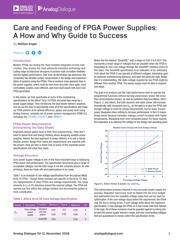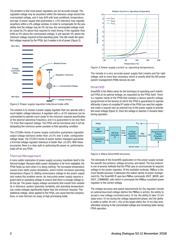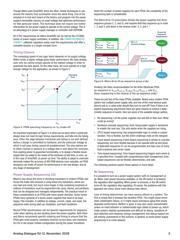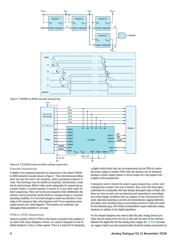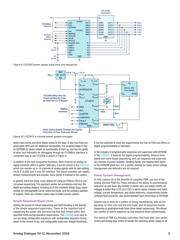Datasheet 搜索 > ADI(亚德诺) > LTC2978AIUP#TRPBF 数据手册 > LTC2978AIUP#TRPBF 产品设计参考手册 1/13 页
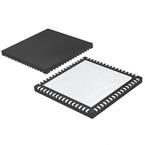
 器件3D模型
器件3D模型¥ 13.897
LTC2978AIUP#TRPBF 产品设计参考手册 - ADI(亚德诺)
制造商:
ADI(亚德诺)
封装:
QFN
Pictures:
3D模型
符号图
焊盘图
引脚图
产品图
页面导航:
功能描述在P1P13
导航目录
LTC2978AIUP#TRPBF数据手册
Page:
of 13 Go
若手册格式错乱,请下载阅览PDF原文件

Analog Dialogue 52-11, November 2018
1
Notice the line labeled “SmartVID,” with a range of 0.82 V to 0.93 V. This
represents a broad range of voltages that are possible when the FPGA is
requesting its own core voltage through the SmartVID
2
interface (more on
this later). This SmartVID specification is an indication of an underlying
truth about the FPGA: it can operate at different voltages, depending upon
its particular manufacturing tolerance, and upon the particular logic design
that it is implementing. The static voltage required by one FPGA might be
different from another FPGA. The power supply must be able to respond
and adapt.
The goal is to produce just the right performance level to operate the
programmed functions without burning unnecessary power. We know
from semiconductor physics, as well as published data from Altera, Xilinx
®
(Figure 1), and others, that both dynamic and static power will increase
dramatically with increased core V
DD
, so the goal is to give the FPGA just
enough voltage to meet its timing requirements, but no more. Excess
power dissipation does nothing to increase performance. In fact, it makes
things worse because transistor leakage current increases with higher
temperatures, dissipating even more unwanted power. For these reasons,
the imperative is to optimize the voltage for the design and operating point.
–10
–15
–5
0
5
10
15
20
–20
–6 –2–4 0 2 4 6
Percent Power Change
Percentage Voltage Change
Relative Power Change with Core Voltage Change
% Static Power
% Dynamic Power
Figure 1. Xilinx Virtex V power vs. core V
CC
.
This optimization process requires a very accurate power supply for
success. Regulator inaccuracy must be baked into the error budget
and subtracted from the available voltage range that can be used for
optimization. If the core voltage drops below the requirement, the FPGA
may fail due to timing errors. If core voltage drifts above the maximum
specification, it may damage the FPGA, or it may create hold-time failures
in the logic. All of these scenarios must be guarded against by taking into
account the power supply tolerance range, and only commanding voltages
that are guaranteed to remain within the specification limits.
analogdialogue.com
Introduction
Modern FPGAs are among the most complex integrated circuits ever
created. They employ the most advanced transistor technology and
cutting-edge architectural structures to achieve both incredible flexibility
and the highest performance. Over time, as technology has advanced, this
complexity has dictated certain compromises in the design and implemen-
tation of systems using the FPGAs. This is nowhere more apparent than in
the power supplies, which must be ever more accurate, more agile, more
controllable, smaller, more efficient, and more fault aware with each new
FPGA generation.
In this article, we look specifically at some of the constraining
specifications for the Altera
®
Arria 10 FPGA, and what they mean for a
power supply design. Then we discuss the best power delivery solutions,
and lay out the plan to successfully meet all of the specifications and make
our FPGA perform at its optimal efficiency, speed, and power level using
Analog Devices’ complete set of power system management (PSM) ICs,
including the LTC3887, LTC2977, and LTM4677.
FPGA Power Requirements
(Interpreting the Data Sheet)
Engineers should spend most of their time programming—they don’t
want to spend time and energy thinking about designing suitable power
supplies. Indeed, the best approach to power delivery is to use a robust,
flexible, proven design that meets the requirements and expands with
the project. Here we take a closer look at some of the important power
specifications and what they mean.
Voltage Accuracy
Core power supply voltage is one of the most important keys to balancing
FPGA power and performance. The specification documents give a range of
acceptable voltages, but the total range is not the complete picture. As with
all things, there are trade-offs and optimizations to be made.
Table 1 is an example of core voltage specifications from the popular Altera
Arria 10 FPGA.
1
Though these numbers are specific to the Arria 10, they
are representative of other FPGA core voltage requirements. The range
amounts to a ±3.3% tolerance around the nominal voltage. The FPGA will
operate just fine within this voltage window, but the complete picture is
more complicated.
Table 1. Altera Arria 10 Core Voltage Specification
Symbol Description
Condition Minimum Typical
Maximum Unit
V
CC
Core voltage
power
supply
Standard
and low
power
0.87
0.92
0.9
0.95
0.93
0.98
V
V
SmartVID
0.82 0.93 V
Care and Feeding of FPGA Power Supplies:
A How and Why Guide to Success
By Nathan Enger
Share on
器件 Datasheet 文档搜索
AiEMA 数据库涵盖高达 72,405,303 个元件的数据手册,每天更新 5,000 多个 PDF 文件
